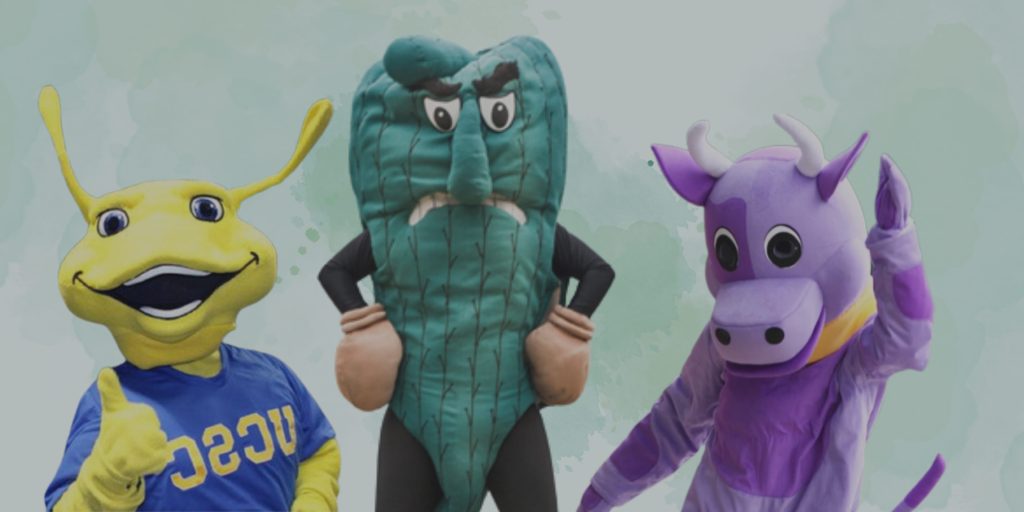College sports are a big deal in the US, and so are the mascots that represent them. Mascots are supposed to inspire pride, loyalty, and spirit among the students and fans. But some mascots are so weird that they might inspire confusion, laughter, or even fear. Here are some of the weirdest US college mascots that you might not believe exist.
The Fighting Okra – Delta State University
Delta State University in Mississippi is known for its green and white colours, but also its bizarre mascot: the Fighting Okra. Yes, you read that right. An okra is a vegetable that is commonly used in Southern cuisine, but not so commonly used as a symbol of athletic prowess. The origin of the Fighting Okra is unclear, but some say it was a joke that stuck, while others say it was a response to the official mascot, the Statesmen, which was too bland and generic. The Fighting Okra has a fierce expression, a boxing glove, and a slogan: “Fear the Okra”
The Banana Slug – University of California, Santa Cruz
The University of California, Santa Cruz is home to one of the most unique and beloved mascots in the country: the Banana Slug. A banana slug is a slimy yellow mollusc that lives in the forests of the Pacific Northwest. It has nothing to do with sports, but everything to do with the campus culture of UCSC, which is known for its environmentalism, activism, and diversity. The Banana Slug was chosen by the students in 1986 as a protest against the administration’s attempt to change the mascot to something more conventional, like a sea lion. The students won, and the Banana Slug became a symbol of their identity and values.
The Billiken – Saint Louis University
Saint Louis University in Missouri has a mascot that is hard to describe: the Billiken. A Billiken is a mythical creature that resembles a cross between a Buddha and an elf. It has a pointed head, a chubby body, and a mischievous smile. It is said to be a charm for good luck and to have the power to grant wishes. The Billiken was created by an American art teacher in 1908 and became a popular toy and souvenir in the early 20th century. Saint Louis University adopted it as its mascot in 1911 after a football coach saw a statue of it and thought it looked like one of his players. The Billiken is still a source of pride and fun for the SLU community.
The Artichoke – Scottsdale Community College
Scottsdale Community College in Arizona has a mascot that might make you hungry: the Artichoke. An artichoke is a thorny vegetable that is often eaten with butter or mayonnaise. It is also the unlikely emblem of SCC, thanks to a student vote in 1970. The vote was meant to be a prank, as well as a protest against the school’s budget cuts and tuition hikes. The students chose the Artichoke to mock the administration and to show their dissatisfaction with the college’s policies. The Artichoke stuck around and became a way for SCC to stand out from other colleges.
The Purple Cow – Williams College
Williams College in Massachusetts is one of the most prestigious liberal arts colleges in the US, but also one of the most whimsical when it comes to its mascot: the Purple Cow. A purple cow is exactly what it sounds like a purple cow. It is also a reference to a famous poem by Gelett Burgess, which reads: “I never saw a purple cow / I never hope to see one / But I can tell you anyhow / I’d rather see than be one.” The Purple Cow was chosen as Williams’ mascot in 1907 by the student humour magazine, which was also called The Purple Cow. The Purple Cow is still used today as a mascot for Williams’ sports teams and student organizations.
The Geoduck (Evergreen State College)
Moving on, we encounter the Geoduck, the mascot of Evergreen State College. Pronounced “gooey-duck,” this unique creature is a giant clam known for its rather suggestive appearance. The Geoduck represents the college’s commitment to embracing the unconventional and thinking outside the box.
The Fighting Pickle (University of North Carolina School of the Arts):
The University of North Carolina School of the Arts boasts a peculiar mascot known as the Fighting Pickle. This green, muscular pickle exudes an unexpected sense of determination. It serves as a playful representation of the school’s creative spirit and adds a touch of whimsy to their athletic events.
The Stormy Petrel (Oglethorpe University):
Oglethorpe University in Atlanta, Georgia, embraces an unusual mascot, the Stormy Petrel. This seabird, known for its fierce nature, is an unconventional choice but perfectly captures the university’s tenacity and resilience in the face of challenges.
The Blue Blob (Xavier University):
Xavier University‘s Blue Blob is a peculiar, blue, amoeba-like creature with googly eyes and a wide grin. While it may not resemble any living organism, the Blue Blob represents the university’s school spirit and adds an element of fun to its athletic events.
The Zips (University of Akron):
The University of Akron’s mascot is simply called the Zips. While it might not sound particularly strange at first, the mascot’s appearance is an anthropomorphic kangaroo with a basketball jersey. The Zips symbolize the university’s commitment to energy, speed, and agility.
The Cobbers (Concordia College):
Concordia College in Minnesota is known for its mascot, the Cobber. Derived from “Coburg,” a term for a hardy farmer, the Cobber is represented by a corn cob wearing a farmer’s hat. This unique mascot pays tribute to the college’s agricultural heritage.
The Ichabod (Washburn University):
Lastly, we have Ichabod, the mascot of Washburn University in Kansas. Inspired by Washington Irving’s “The Legend of Sleepy Hollow,” Ichabod represents the college’s rich literary tradition and adds a sense of mystique and intrigue to their athletic programmes. The Ichabod’s distinctive top hat and old-fashioned attire make for a truly unconventional and memorable mascot.
Conclusion
These are just a few instances of the most Weirdest US college mascots that have had an enduring impression on the world of collegiate athletics, from slimy slugs to aggressive okras, and from giggly pickles to enigmatic Ichabods. These mascots may not fit the stereotype of fearsome creatures or mythical warriors, but they nonetheless represent the distinctive character, principles, and cultures of the organisations they represent. They give the game a whimsical touch, provide priceless moments, and serve as a reminder that collegiate sports can welcome the unexpected. Therefore, the next time you encounter one of these peculiar icons, keep in mind how much originality and ingenuity they have contributed to the world of collegiate athletics. They demonstrate the diversity of campus spirit and the fact that being eccentric may occasionally be a strength.
FAQs
Why do colleges choose weird mascots?
Colleges choose weird mascots to stand out, create a unique identity, and generate attention. Unconventional mascots can also reflect local culture or industry and add humour to foster school spirit.
Do weird mascots affect a college’s reputation?
Weird mascots have varying impacts on a college’s reputation. Some find them amusing, while others may view them as odd. A college’s reputation is influenced by numerous factors beyond its mascot, such as academic programmes and campus culture.
What are the benefits of having a weird mascot?
Weird mascots create a memorable brand, generate media attention, and encourage engagement. They foster fun, unity, and school spirit among students, alumni, and fans.
Are there downsides to having a weird mascot?
Some may not take a college with a strange mascot seriously or associate it with athletic prowess. There is a risk of being seen as gimmicky or unprofessional, which can impact the college’s image.
Can colleges change their mascot if it’s too weird?
Yes, colleges can change mascots if desired. The process involves consultation with stakeholders and can be driven by rebranding, updating the college’s image, or addressing concerns about cultural sensitivity. Involving the community ensures a smooth transition to the new mascot.
PS: If there’s anything more you want to know about, add it to the comments section!
Thank you for reading this blog post on Weirdest US College Mascots. We hope that it has provided valuable information for prospective students considering this university. Check out our other blogs of interest:


















1 thought on “Top PGDM Courses In Canada: Universities & Eligibility”
I have done Bachelor’s in Culinary Arts from India and completed my graduation in the year 2022 .I am 22 years old. After graduation, I have done 1 year paid internship from USA .Now, I would like to take occupational experience and learn culinary skills and also do masters in Culinary arts.How can I find the college n best course / country where I can persue studying further